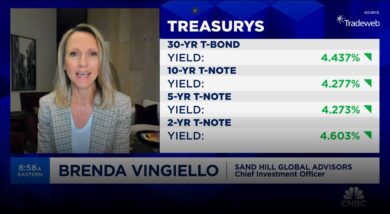Sand Hill's Chief Investment Officer, Brenda Vingiello, CFA, joins Jenny Harrington on “Halftime Report” to go over their most recent portfolio moves. Brenda's commentary begins

Executive Deferred Compensation Plans: Yay or Nay?
Nonqualified Deferred Compensation (NQDC) Plans are a benefit often offered by corporations to high ranking executives, usually Directors and above. They are distinctly different from qualified retirement plans such as pensions or 401(k)s, and since NQDC plans are not widely offered, the pros and cons of participating are not widely understood. Whether to participate is a question that often comes up with my clients who are executives at publicly traded companies, so I thought I would share some perspective on when and how to participate.
NQDC plans allow participants to defer income from immediate taxation by placing those pre-tax dollars into investment pools held in trust by the company, taking advantage of compounded growth on the pre-tax balance. Distributions from the plan are taxed as ordinary income and typically cannot occur until retirement, termination from the company, or per the agreed-upon distribution schedule established at enrollment (typically over a 10-year period). By deferring the taxation on the income to a later date, such as in retirement, the participant could benefit from tax savings if their tax bracket in the future is lower than when the income was originally earned – during prime working years.
A plan is considered “nonqualified” because it is a flexible compensation arrangement between employer and employee. The plan can be offered to certain employees while excluding others. The company can also choose the distribution schedule, contribution limits, and company match – and even offer varying levels of these features to different employees. In contrast, one of the basic characteristics of a “qualified” plan is the same plan must be offered to all employees, regardless of rank or compensation level. Because of this flexibility, NQDC plans are often used as a tool to attract and retain top talent.
To further incentivize participation, companies often offer a matching program up to a certain portion of compensation. It is important to recognize that the matching percentage offered – say 5% – does not necessarily translate to the participant withholding that same 5%. There is a simple calculation to determine the right contribution percentage, which should be computed and understood prior to enrollment. Also, any company match is essentially free money the employee would forgo if they chose to abstain. At a minimum, one can consider contributing at the lowest percentage possible to take advantage of the match.
Since NQDC plans are unique to each company, plan documents should be thoroughly reviewed to understand the contribution limits, distribution schedule and how the plan is treated at termination. It should be acknowledged that the employee’s NQDC assets are held in trust by the company, making all future payments subject to the health of the company. Unlike qualified plans like 401(k)s, all NQDC assets are typically not protected from creditors of the company.
With NQDC plans, just because the plan was offered one year does not guarantee it will be available in subsequent years. As such, enrollment must be acted upon each year the plan is offered – participation does not automatically carry over. In the case of a distribution schedule over a 10-year period, that would mean the participant could potentially have a rolling schedule with many layers of deferred compensation stacked upon one another (one layer for each year of participation). This is another element to consider when participating for consecutive years. The income might be deferred, but it will eventually catch up to the participant and increase future years’ overall taxable income when you consider salary, bonus, investment gains, plus multiple years of built up deferred compensation.
If retirement is on the horizon, deferred compensation plans can be a very useful tool to spread income into those later years when the participant might be in a lower tax bracket. For those who are not nearing retirement, deferring compensation could push the additional income into years when you are actually earning more than you are today! Also, since NQDC’s are utilized as a retention tool, it should also be evaluated whether participation makes sense if there are plans to leave the company in the near future.
Ultimately, deferred compensation plans are a great employee benefit, but as with all financial decisions, participation should be carefully evaluated to understand both the default risks and the full impact to one’s income levels in future years. At a minimum, participation might make sense simply to take advantage of the company match. Since plan specifics vary from company to company, a deep dive into the specific plan parameters is critical to evaluating the pros and cons of participation. This is an endeavor your Sand Hill Senior Wealth Manager is ready to undertake on your behalf.
Articles and Commentary
Information provided in written articles are for informational purposes only and should not be considered investment advice. There is a risk of loss from investments in securities, including the risk of loss of principal. The information contained herein reflects Sand Hill Global Advisors' (“SHGA”) views as of the date of publication. Such views are subject to change at any time without notice due to changes in market or economic conditions and may not necessarily come to pass. SHGA does not provide tax or legal advice. To the extent that any material herein concerns tax or legal matters, such information is not intended to be solely relied upon nor used for the purpose of making tax and/or legal decisions without first seeking independent advice from a tax and/or legal professional. SHGA has obtained the information provided herein from various third party sources believed to be reliable but such information is not guaranteed. Certain links in this site connect to other websites maintained by third parties over whom SHGA has no control. SHGA makes no representations as to the accuracy or any other aspect of information contained in other Web Sites. Any forward looking statements or forecasts are based on assumptions and actual results are expected to vary from any such statements or forecasts. No reliance should be placed on any such statements or forecasts when making any investment decision. SHGA is not responsible for the consequences of any decisions or actions taken as a result of information provided in this presentation and does not warrant or guarantee the accuracy or completeness of this information. No part of this material may be (i) copied, photocopied, or duplicated in any form, by any means, or (ii) redistributed without the prior written consent of SHGA.
Video Presentations
All video presentations discuss certain investment products and/or securities and are being provided for informational purposes only, and should not be considered, and is not, investment, financial planning, tax or legal advice; nor is it a recommendation to buy or sell any securities. Investing in securities involves varying degrees of risk, and there can be no assurance that any specific investment will be profitable or suitable for a particular client’s financial situation or risk tolerance. Past performance is not a guarantee of future returns. Individual performance results will vary. The opinions expressed in the video reflect Sand Hill Global Advisor’s (“SHGA”) or Brenda Vingiello’s (as applicable) views as of the date of the video. Such views are subject to change at any point without notice. Any comments, opinions, or recommendations made by any host or other guest not affiliated with SHGA in this video do not necessarily reflect the views of SHGA, and non-SHGA persons appearing in this video do not fall under the supervisory purview of SHGA. You should not treat any opinion expressed by SHGA or Ms. Vingiello as a specific inducement to make a particular investment or follow a particular strategy, but only as an expression of general opinion. Nothing presented herein is or is intended to constitute investment advice, and no investment decision should be made based solely on any information provided on this video. There is a risk of loss from an investment in securities, including the risk of loss of principal. Neither SHGA nor Ms. Vingiello guarantees any specific outcome or profit. Any forward-looking statements or forecasts contained in the video are based on assumptions and actual results may vary from any such statements or forecasts. SHGA or one of its employees may have a position in the securities discussed and may purchase or sell such securities from time to time. Some of the information in this video has been obtained from third party sources. While SHGA believes such third-party information is reliable, SHGA does not guarantee its accuracy, timeliness or completeness. SHGA encourages you to consult with a professional financial advisor prior to making any investment decision.







